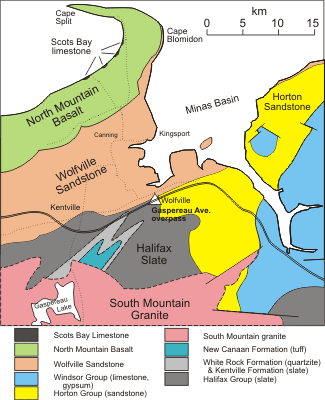Scenery and Geology of Ridge Stile Park
By J.A. Colwell & S.A. Ferguson
 LOCATION - Wolfville Ridge, 1860 m (6200 feet)
south of
Main Street on Highland Avenue.
LOCATION - Wolfville Ridge, 1860 m (6200 feet)
south of
Main Street on Highland Avenue.
ROUTE - Go south on Highland Avenue, pass beneath Highway 101 and continue on the Ridge Road to a right angle bend.
DESCRIPTION - The park offers scenic views northward over the Annapolis (Cornwallis) Valley and Minas Basin and southward over the Gaspereau Valley. A wooden stile used to cross a fence line, but the site is now occupied by concrete steps. The park belongs to the Rotary Club of Wolfville, and is administered by the Town.
The landforms of the area around Wolfville have been strongly influenced by the varying resistance to erosion of the types of rocks present.
The Wolfville Ridge is underlain by resistant slate belonging to the Halifax Group (Cambro-Ordovician, about 500 million years old), and outcrops of these rocks can be seen near the entrance to the park and on the slope just south of the stile. The scenic Gaspereau Valley to the south and east lies in a syncline of more easily eroded sandstone and shale of the Horton Bluff Formation (early Carboniferous, about 340 million years). More slate and granite, the latter part of the South Mountain Batholith (Devonian), are on the high ground further south.
Still younger rocks lie to the north. The boundary between the Halifax Group and the Wolfville formation (Triassic, about 200 million years) crosses the Acadia University campus. The softer sandstone and conglomerate of the Wolfville Formation dip gently north and underlie the southern part of the Annapolis Valley. They are succeeded by the red siltstone of the Blomidon Formation (Triassic) and capped by erosion-resistant basalt flows of the North Mountain Formation (Jurassic) that begin about halfway up the face of North Mountain.
Prepared for the Geological Association of Canada and Mineralogical Association of Canada Joint Annual Meeting in Wolfville, Nova Scotia, May 25-27, 1992. Meeting Hosted by the Atlantic Geoscience Society.
